Disclaimer: This post may contain Amazon affiliate links. Sudachi earns a small percentage from qualifying purchases at no extra cost to you. See disclaimer for more info.
What is Chawanmushi?
Chawanmushi (茶碗蒸し) is a dish made by steaming ingredients such as shiitake mushrooms, fish cakes, chicken, and/or shrimp in an egg and dashi stock soup mixture. Japanese cuisine treats it as soup and serves it as an appetizer or side dish.
The word “chawan” (茶碗) means teacup or bowl, and “mushi” (蒸し) means to steam. Together, it becomes “steamed teacup” and refers to the container and cooking method used for the dish.
The flavor of the egg and the delicate dashi broth combined with the smooth texture creates an exquisite combination. Chawanmushi is a perfect example of an elegant dish that uses relatively simple ingredients.
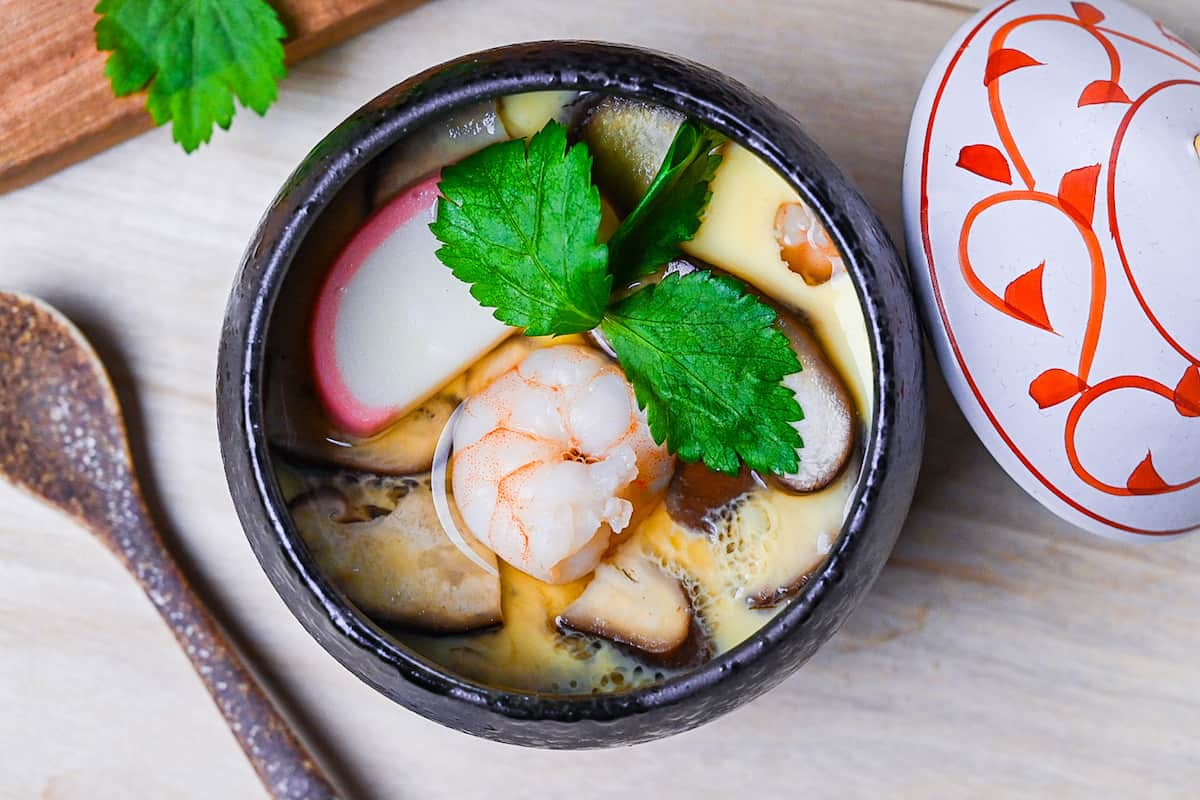

How I Developed This Recipe
Chawanmushi is a Japanese classic that always brings a sense of “Wa (和)” to my kitchen. It’s warm, comforting, and has a gentle, soothing taste.
This time, I tried to make it look as nice as possible, while still staying true to its traditional roots. Since it’s a delicate dish, I’ve included a few tips to make it simple to recreate.
If you’re looking for a truly Japanese experience, I highly recommend trying chawanmushi!
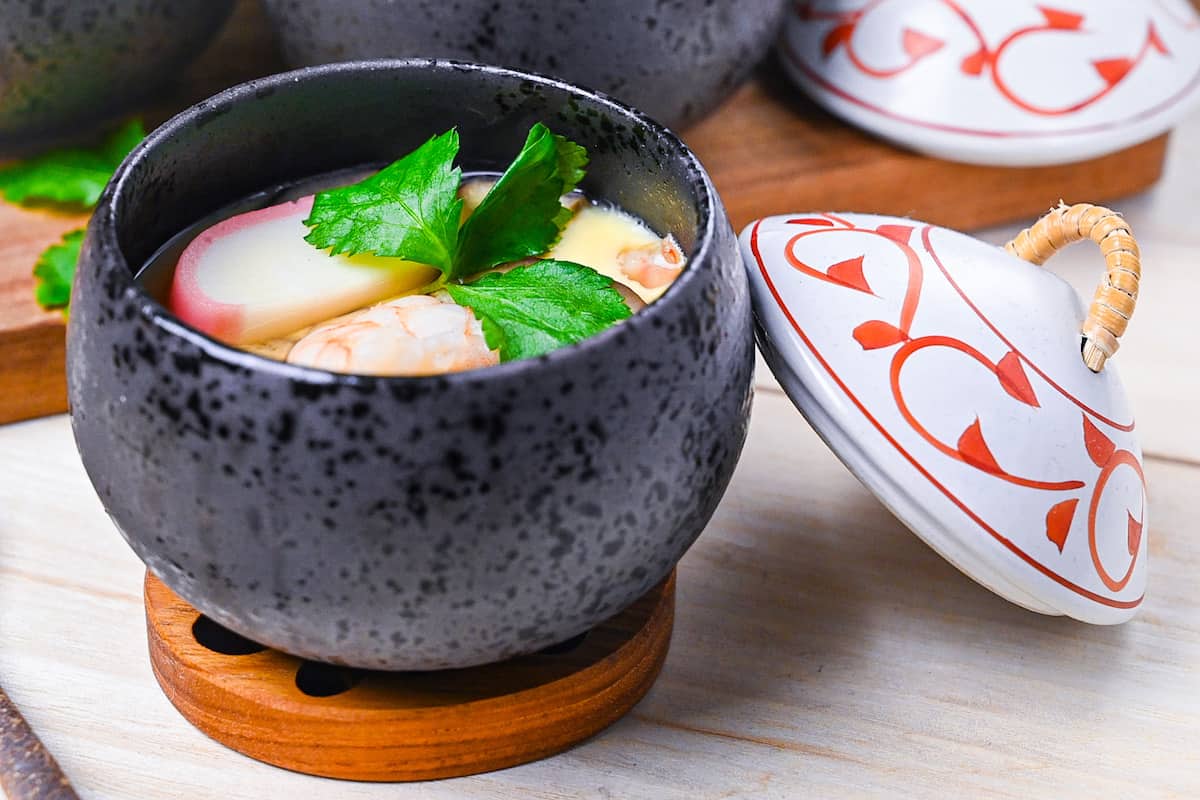
Cups/Bowls: Alternative Options Explained
Chawanmushi bowl/cup is a particular dish used to make chawanmushi, and it is generally shaped like a Japanese teacup but taller. Many chawanmushi bowls are sold as a set with a lid to prevent water droplets from getting mixed in when steaming chawanmushi. The lid also keeps the aroma of the ingredients from escaping.
They come in various designs, from seasonal plants and animals to simple white, making them visually interesting objects. Surprisingly, there are quite a few designs available on Amazon, from classic style chawanmushi cups like this to very modern/stylish chawanmushi cups like this.
Chawanmushi cups are beautiful but strong and durable, so they can withstand high temperatures when steaming. Because of this, it is actually a surprisingly useful piece of Japanese tableware, as it can be used not only for chawanmushi but also as a cup for desserts such as zenzai or even cold desserts like ice cream.
Nevertheless, chawanmushi is not a dish that is frequently made, even in Japanese households. Therefore, some do not want to go out of their way to buy chawanmushi cups.
In such cases, you can make chawanmushi in a ramekin (or something similar with heatproof properties) covered with aluminum foil. I will show you how to do that later in this recipe.
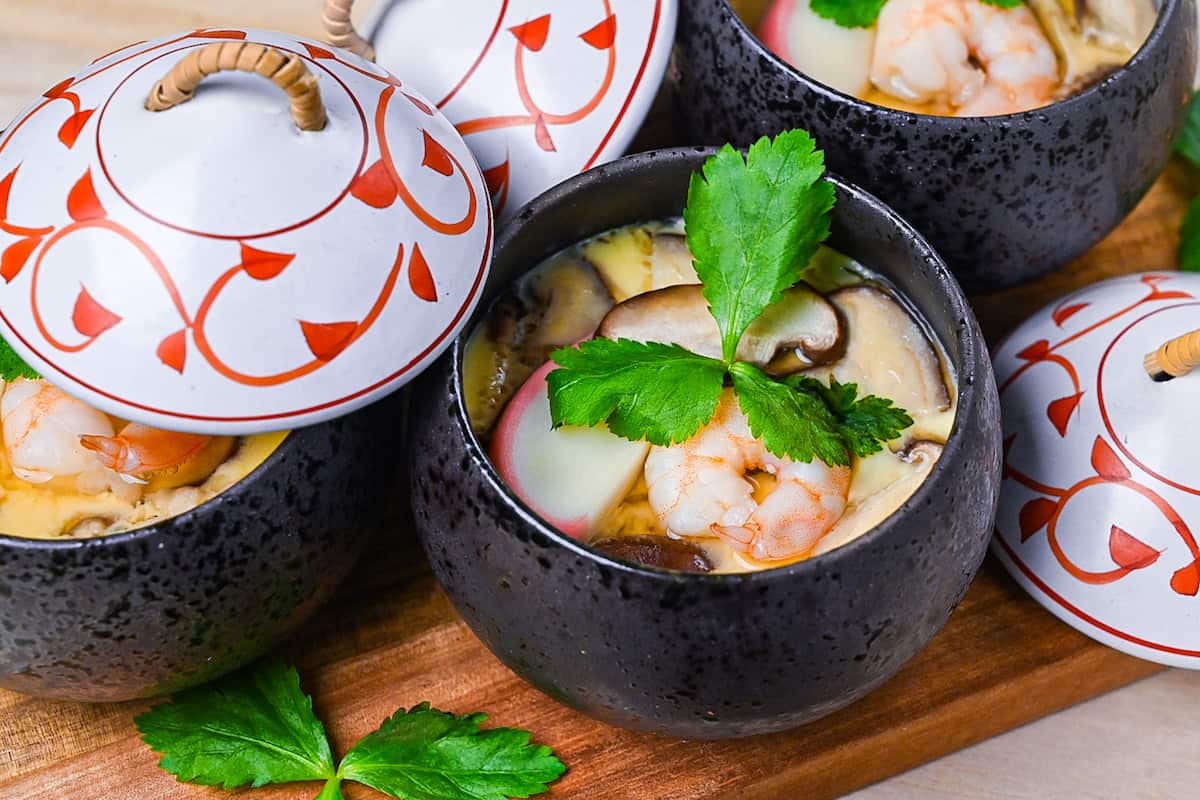
Ingredients & Substitution Ideas
- Eggs: I usually use large eggs, with each egg being about 55-60ml or 2 floz.
- Dashi Broth: This is the key to the dish’s flavor. You can go for either awase dashi or a vegan option. If you’re in a rush, instant dashi granules or packets work just fine.
- Kamaboko Fish Cake: In my opinion, kamaboko is an essential ingredient. It’s a white fish cake that’s steamed into loaves. It’s mildly flavored and a bit rubbery. Imitation crab sticks are a good substitute if it’s hard to find.
- Fresh Shiitake Mushrooms: These mushrooms are large and full of umami flavor. I prefer fresh shiitake, but if you can’t find them, dried ones rehydrated in water are a great alternative.
- Shrimp: I like adding one whole shrimp per serving and cutting the rest into halves or thirds.
- Sake: Unsalted drinking sake is my first choice for its clean flavor.
- Mirin: For the most authentic taste, Hon Mirin is what I use.
- Japanese Parsley (Mitsuba): This is an optional garnish, but I think it adds a nice touch.
Here, I will list all the alternative ingredients, substitutions, and variations against the recipe card below to make the best chawanmushi to your preference:
- Chicken for more meaty flavor: replace with prawns or even add a little bit of chicken in addition to prawns
- Scallops for richer taste: replace with prawns or even add a little bit of scallops in addition to prawns
- Crab: replace with prawns or even add a little bit of crab meat in addition to prawns
- Other types of prawns, including lobster: you might have to cut them smaller depending on the size
- Chikuwa: as humble alternative to kamaboko
- Ginkgo nuts: for an authentic addition
- Other types of mushroom: instead of shiitake mushroom
- Spinach: instead of mitsuba
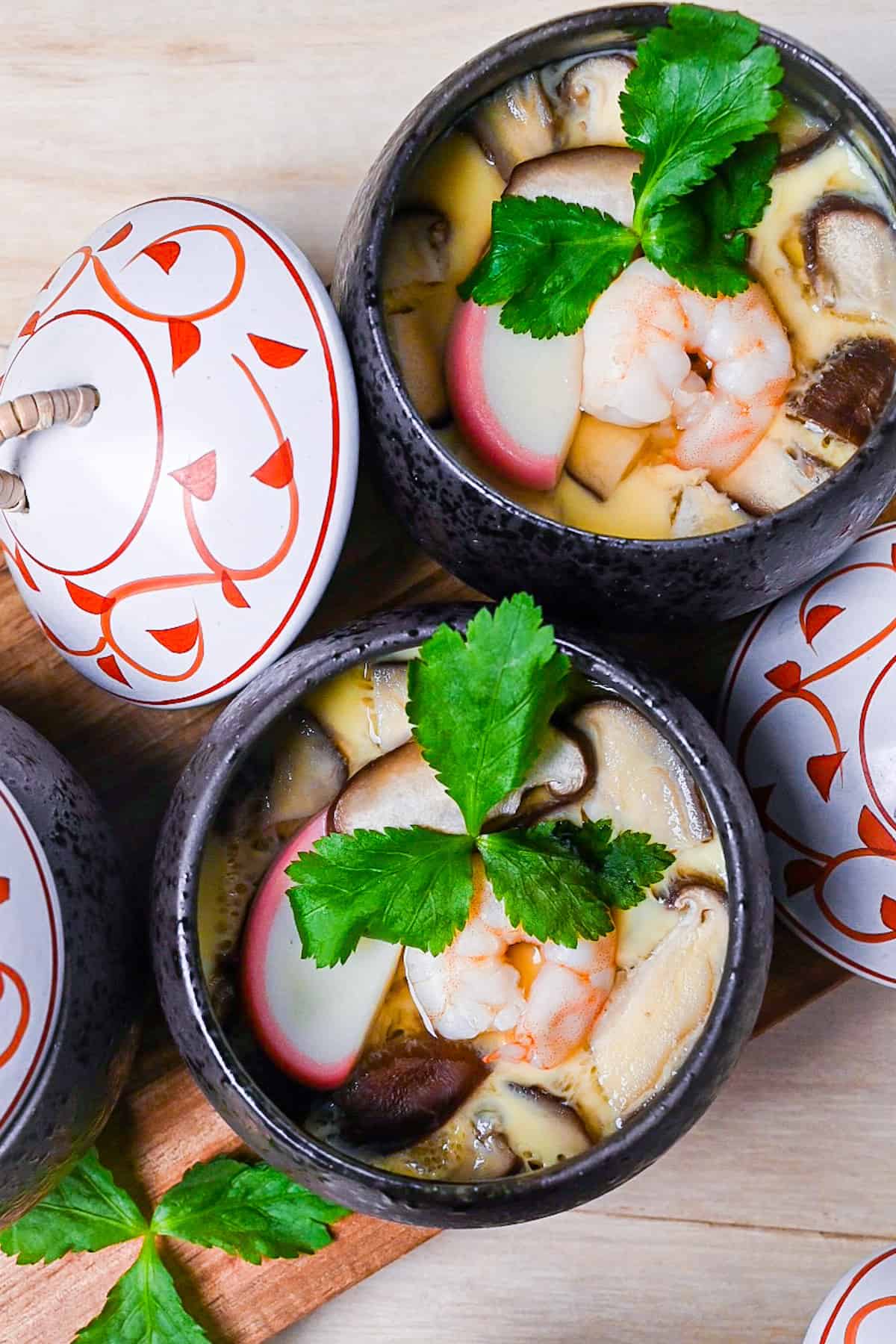
Visual Walkthrough & Tips
Here are my step-by-step instructions for how to make Chawanmushi at home. For ingredient quantities and simplified instructions, scroll down for the Printable Recipe card below.
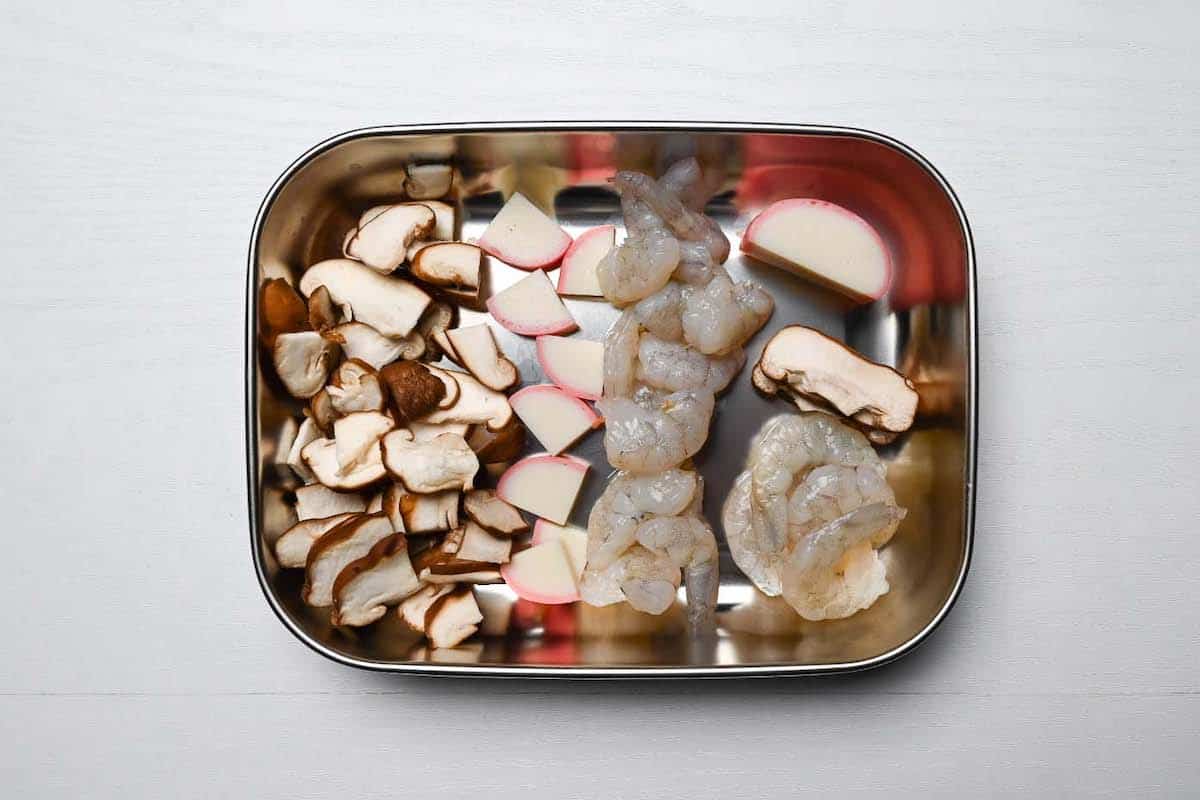
Start by cutting your ingredients into bite-sized pieces; they should be small enough that you never have to try to cut through while eating. I thinly sliced the shiitake mushrooms and kamaboko then cut them in half, the shrimps are cut into halves or thirds depending on the size.
I also recommend setting aside one ingredient for each serving to garnish the top. This is for presentation so if you’re making 4 portions, set aside 4 whole shrimp, 4 slices of kamaboko, and 4 slices of shiitake mushroom.
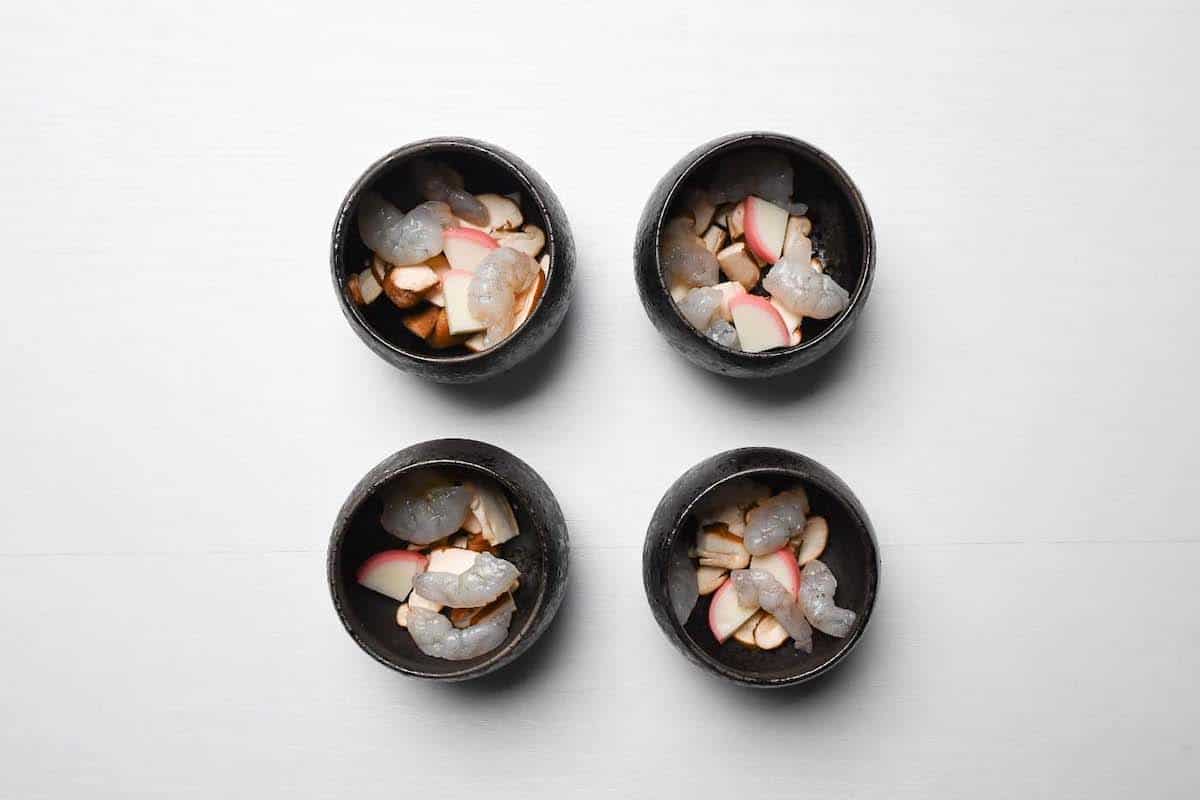
Divide the ingredients evenly between the chawanmushi cups. (It’s also fine to use ramekins or small heatproof bowls.)
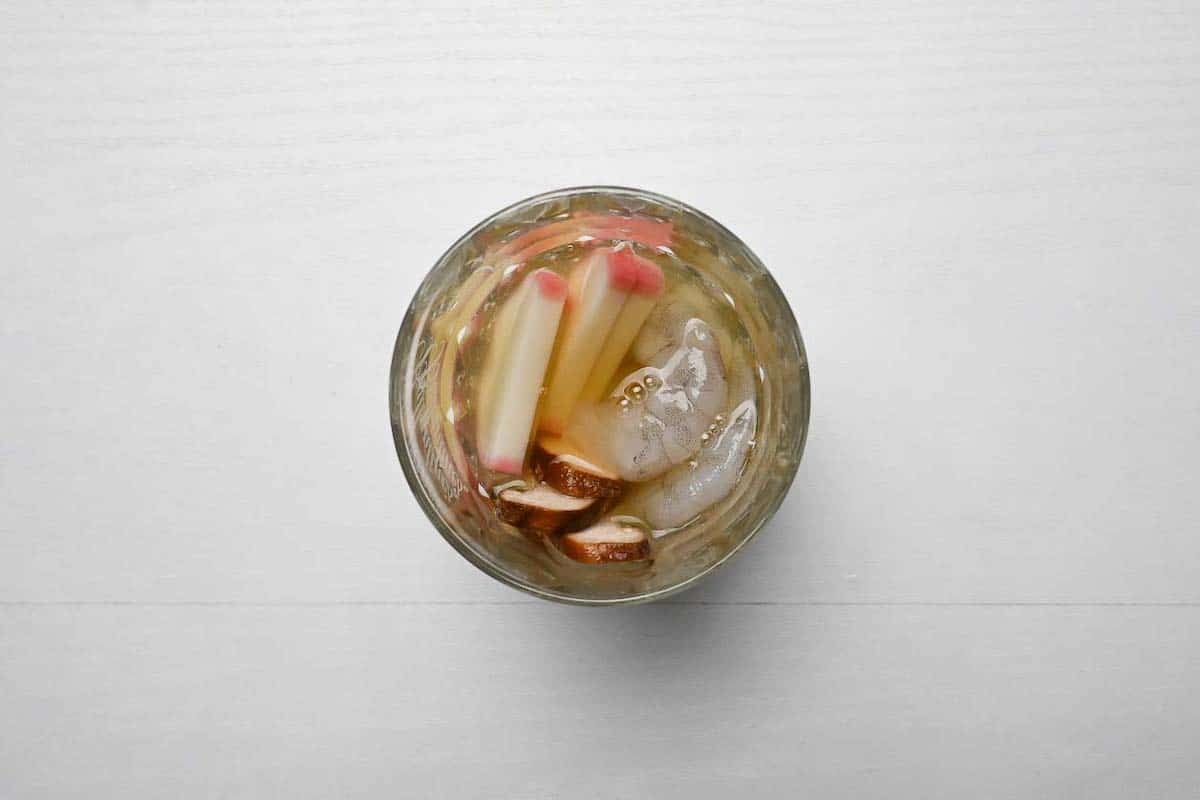
Place the topping ingredients in a separate heatproof bowl and submerge them in dashi (or water). I cook them in the steaming basket together with the chawanmushi, then use them to decorate the top after cooking.
Because chawanmushi mixture is thin, the ingredients tend to sink to the bottom. I steam the toppings in a separate bowl filled with dashi and place them on top at the end.
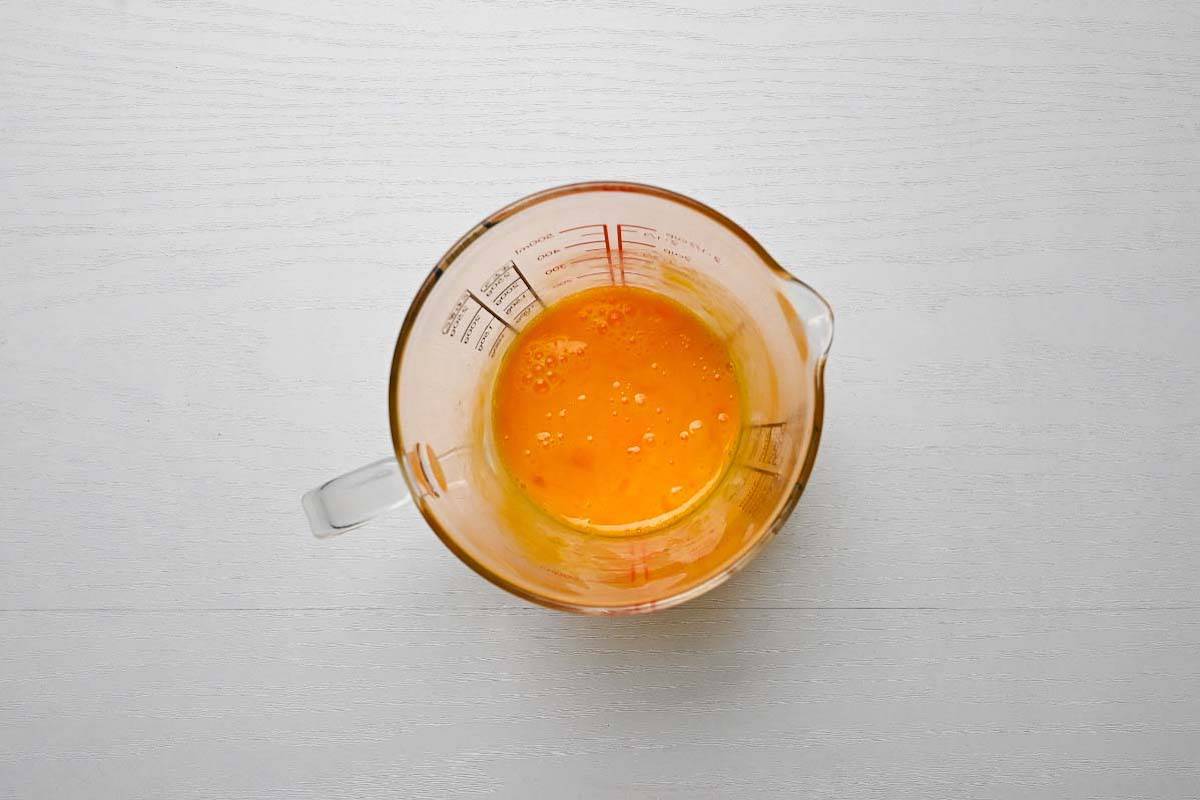
Crack the eggs into a measuring jug and lightly mix it. Use the measurements on the jug to check the volume of egg. From this, you will be able to calculate how much liquid you need to add.
It’s important to know the volume of the egg so that you can accurately calculate how much liquid needs to be added to achieve the perfect silky texture for chawanmushi. The ratio should be 1:3 eggs to liquid.
Chawamushi is a relatively delicate dish, so the egg-to-dashi ratio is very important to make its iconic smooth texture. The general rule of thumb for the ratio is 1 part egg to 3 parts dashi and condiments. (1:3)
Because eggs come in different sizes, I recommend measuring the eggs you use in a measuring cup. Based on my experience, 2 large eggs are approximately 120ml, in that case, 360ml of liquid made up of dashi stock mixed with condiments should be added to make the mixture.
Please note that you cannot replace dashi with water in this recipe, as it’s a vital ingredient.
The perfect egg to dashi ratio in chawanmushi is 1:3, so be sure to measure your eggs!
In this case, my eggs were 120ml, so I needed 360ml of liquid made up of dashi, mirin, and sake. The total mixture will be 480ml at the end. To avoid too many calculations, just work out the total volume needed, add the mirin and sake to the egg, and then top it up with dashi.
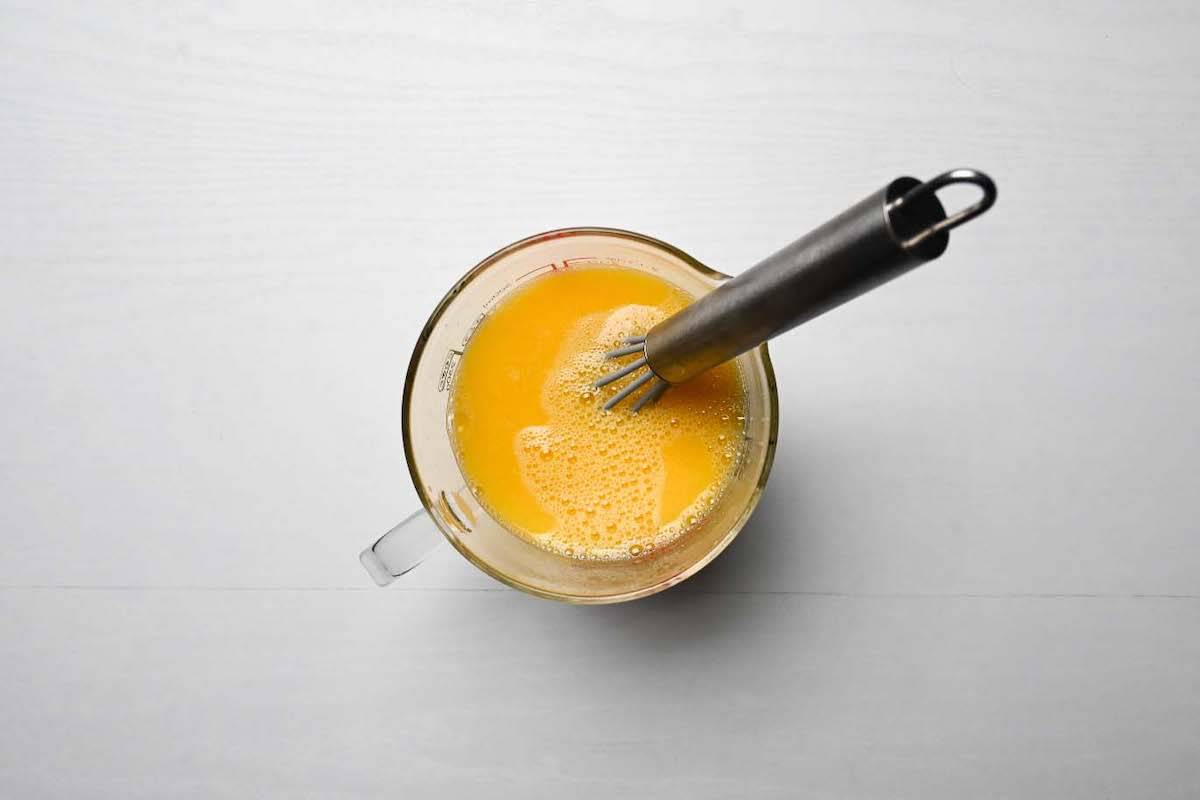
Once you’ve calculated how much the mixture should be in total, add the salt, sake and mirin. After these are added, pour the dashi up to the calculated point. In my case, I filled the jug up to 480ml.
Gently whisk to combine the ingredients. It’s important not to let foam or too many bubbles form in the egg. Chawanmushi has a smooth texture, but if you whisk the egg vigorously, your chawanmushi will have air bubbles, which is not good!
Try your best to prevent air bubbles and foam by whisking gently.
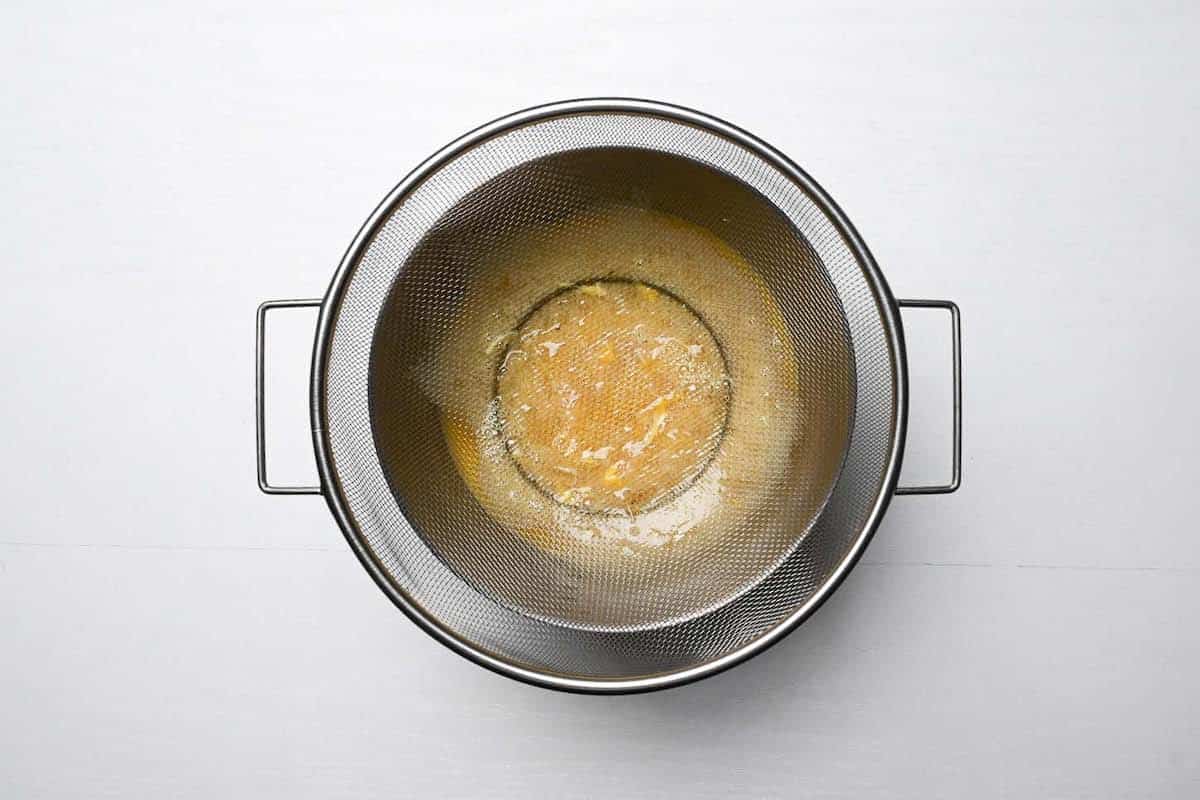
Pouring the mixture through a mesh sieve will make the mixture extra smooth. This step shouldn’t be skipped if you want your chawanmushi to have the perfect texture!
Additionally, if your egg formed a few bubbles during the mixing step, pouring it through a sieve will either break or remove it.
Straining the egg is vital for achieving a smooth and silky chawanmushi.
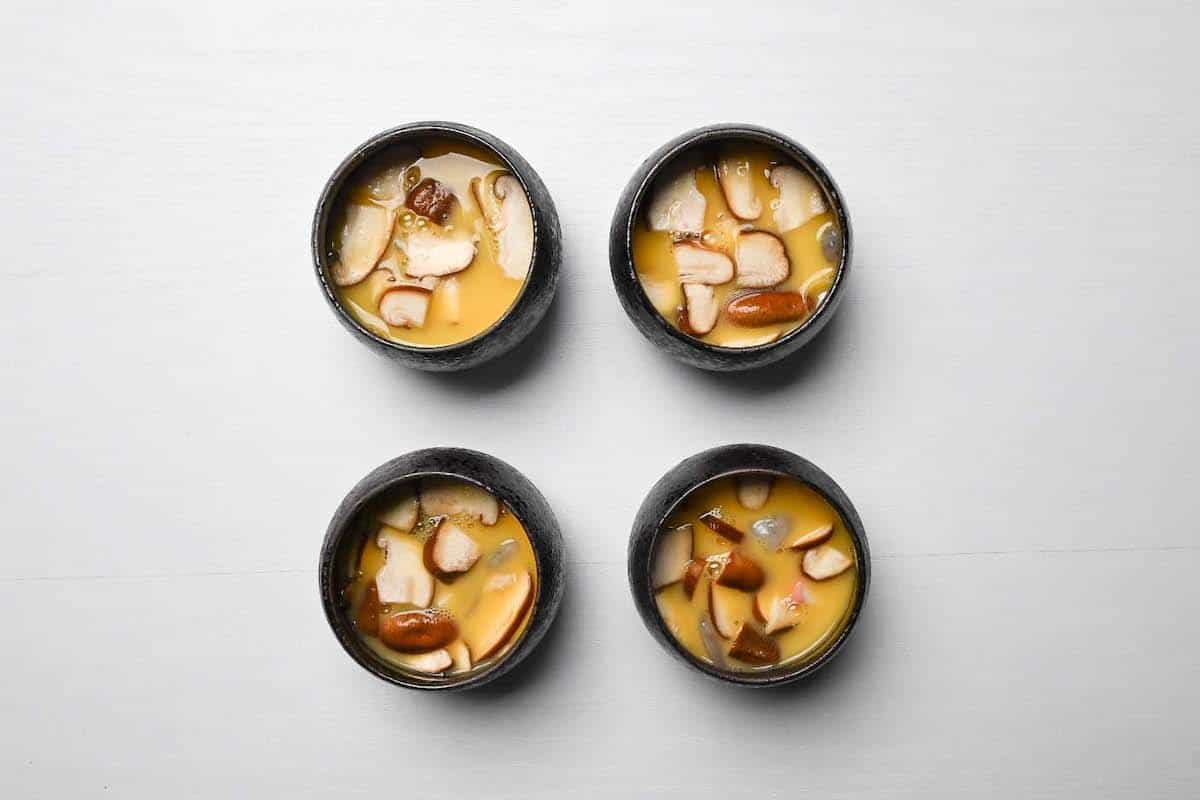
Evenly pour the egg mixture into the containers. My total mixture was 480ml, so that’s 120ml per portion.
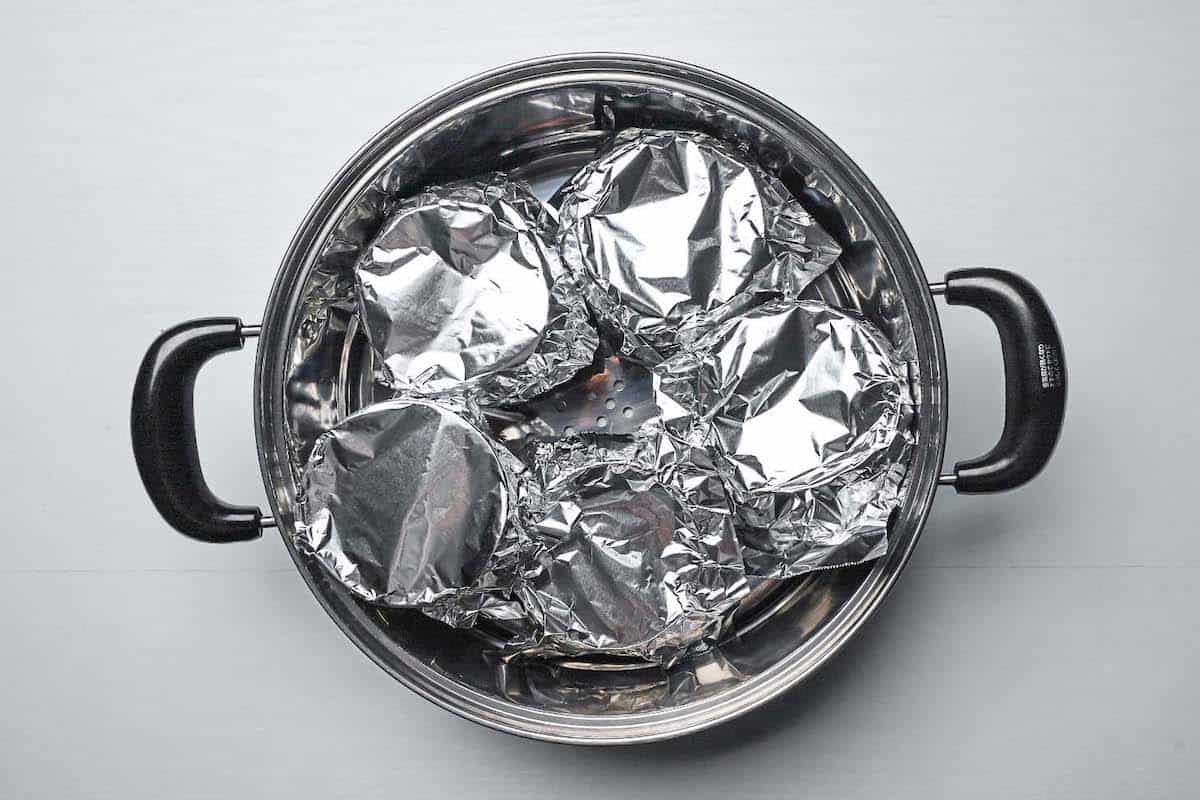
If you steam the chawanmushi uncovered, then drops of water will form on the steamer lid and drop into the mixture. This will ruin the texture of the chawanmushi and make it watery.
Of course, if your containers come with lids, you don’t need to worry about this step.
To prevent drops of water from the steam entering your chawanmushi, top each container with foil or wrap the pot lid with a clean tea towel.
Place the containers (including the one with the toppings) inside a steaming basket.
Add plenty of water to a steamer and bring it to a boil over high heat. Once it’s bubbling, place the steaming basket on top with a lid and steam for 3 minutes on high.
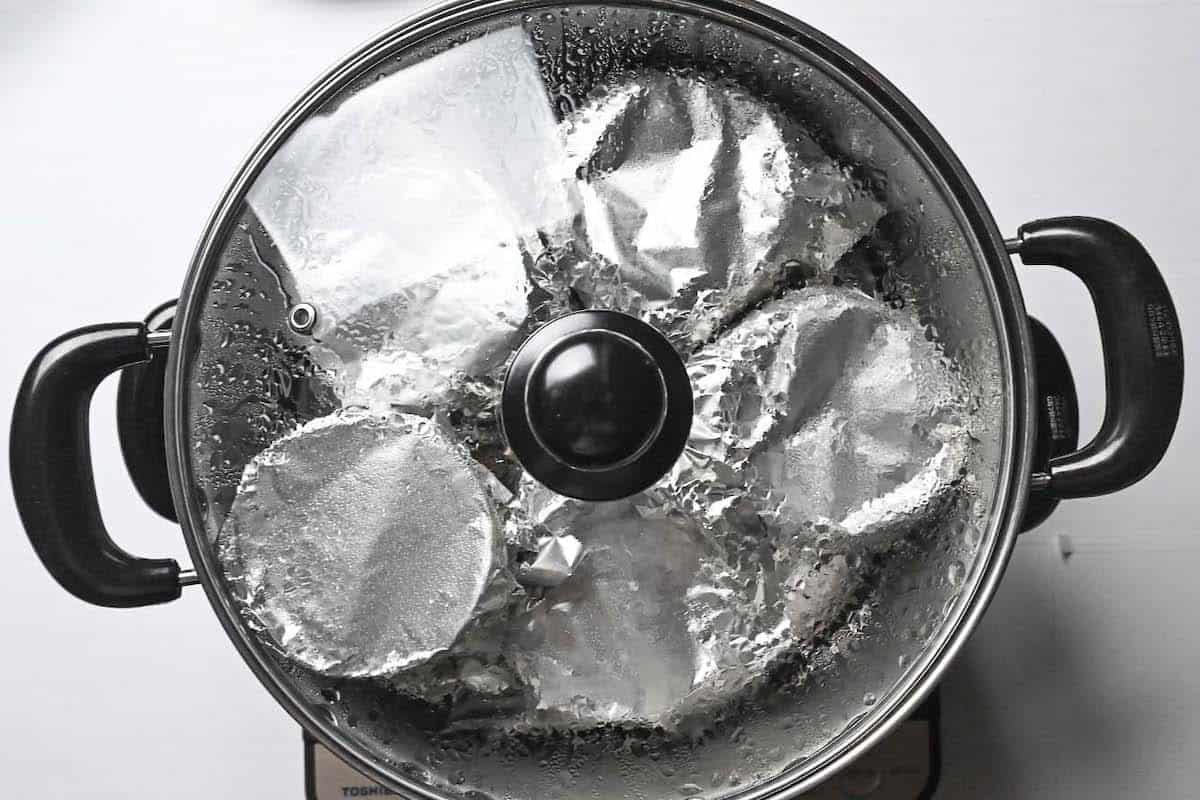
After 3 minutes, turn the heat down to low and simmer for 10 minutes. This is 13 minutes of steaming time in total.
Remove one container from the steaming basket and tilt it gently to make sure they’re set! (Use oven mitts to protect your hands!)
Once the time is up, remove the lid and remove one of the cups. Be careful of burns from the steam or hot containers, I recommend using oven mitts or something similar to protect your hands. Remove the foil and tilt it slightly to make sure it’s set. If it moves, you will need to continue steaming and check every 1-2 minutes until they’re set.
Drain the dashi from the topping ingredients and place one of each ingredient on top of each serving. Garnish with mitsuba (Japanese parsley) and serve hot or cold!
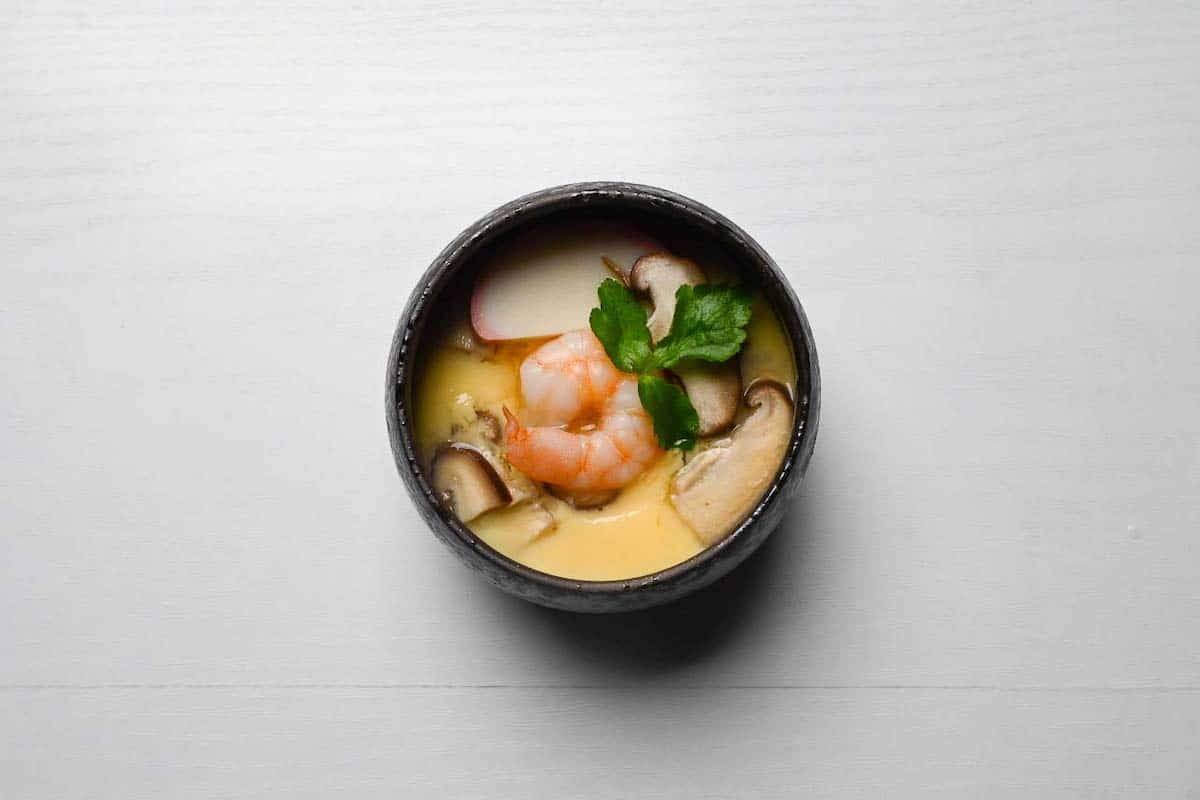
How to Store
Chawanmushi can be stored in the fridge for 1-2 days. You cannot freeze chawanmushi.
You can enjoy it chilled, but in the case that you prefer the dish warm and want to reheat it, I recommend covering the top and placing the container in a bowl of boiling hot water. It will take about 10 minutes to warm all the way through but this gentle method will maintain the silky texture.
Alternatively, some people microwave it. This is risky because the egg can explode and the texture might become rubbery. If you want to try microwaving, a lower wattage is better. Heat it in intervals (about 20 seconds at a time) until it is warmed through. This method is faster, but requires more care.
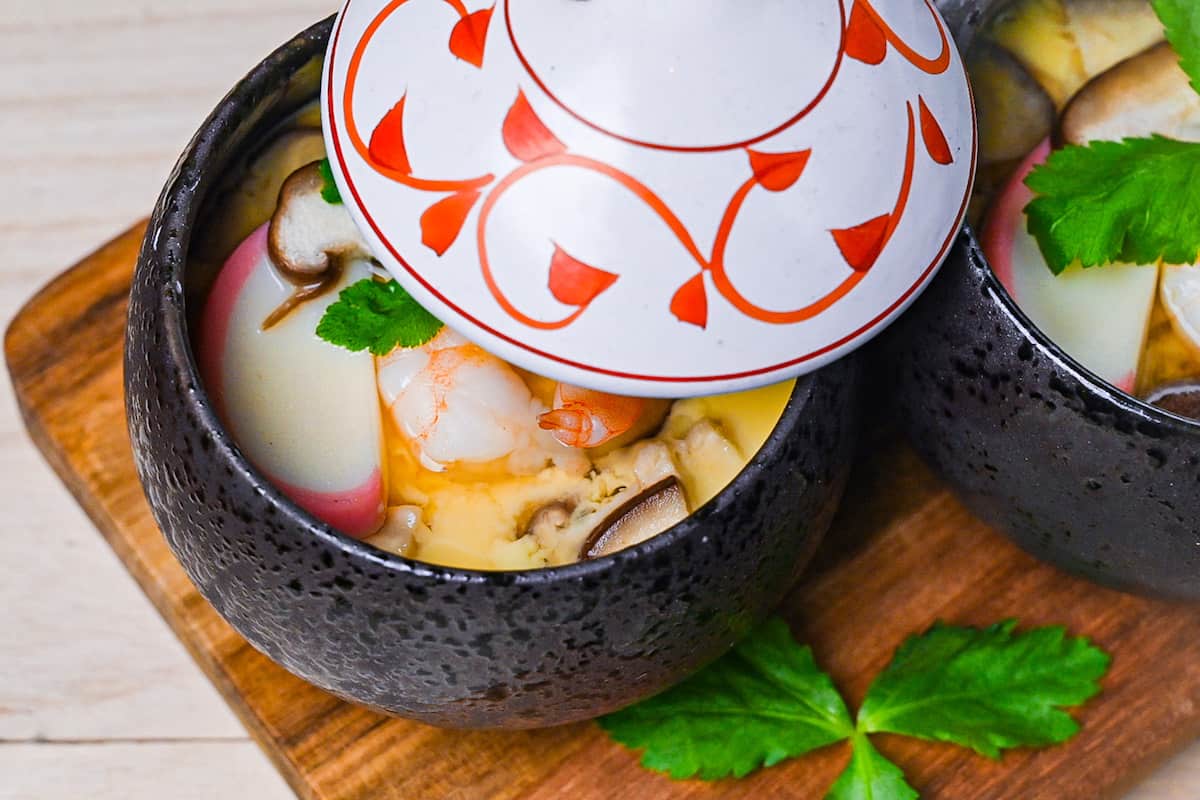
FAQ
Unfortunately, no. Dashi is a vital ingredient for chawanmushi, and it will be too plain without it (the flavor is subtle even with dashi). However, you can use a dashi granule if you don’t want to make a dashi from scratch.
Chawanmushi is usually treated the same way as soup and can be eaten as an appetizer or side dish.
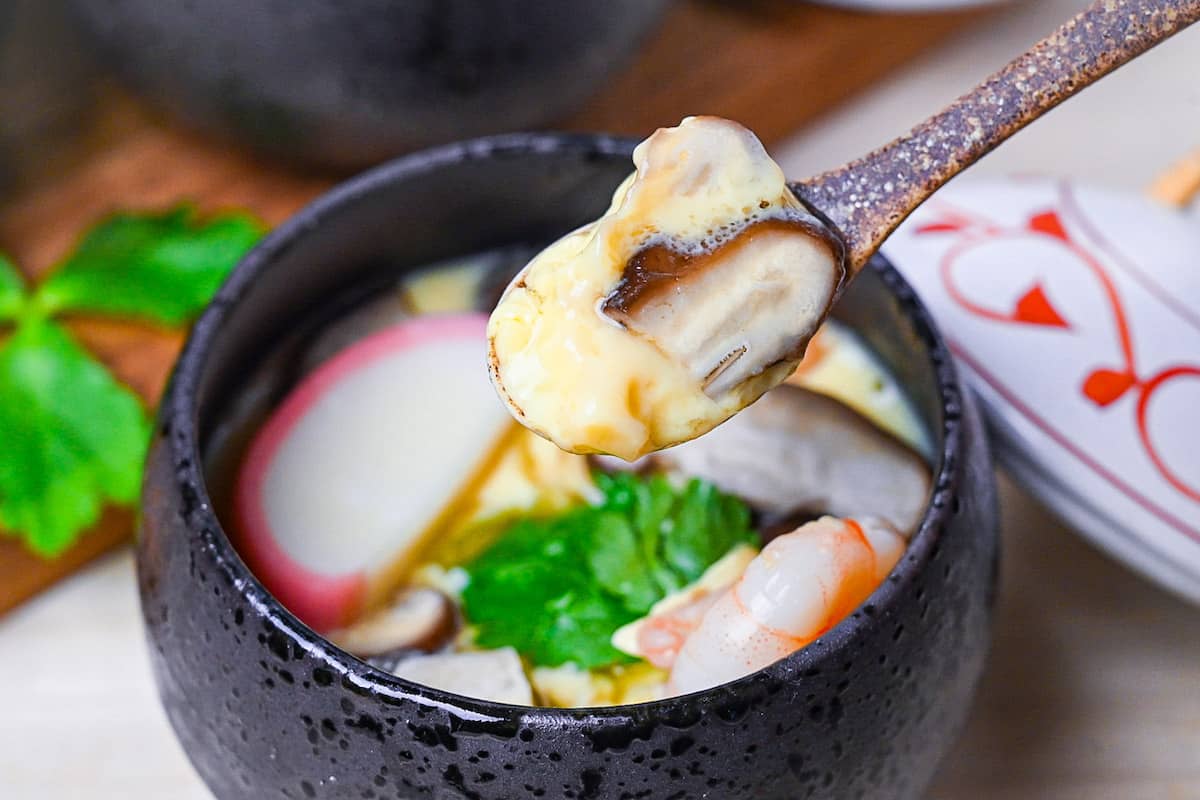
I hope you enjoy this Chawanmushi recipe! If you try it out, I’d really appreciate it if you could spare a moment to let me know what you thought by giving a review and star rating in the comments below. It’s also helpful to share any adjustments you made to the recipe with our other readers. Thank you!
More Japanese Egg Recipes
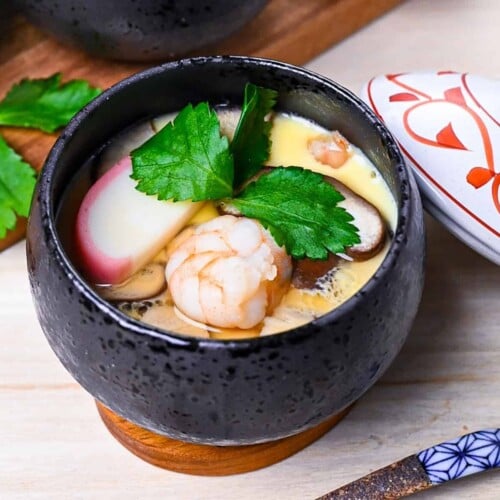
Authentic Chawanmushi (Japanese Steamed Egg Custard)
Ingredients
- 2 egg approx 60ml/2 floz per egg
- ¼ tsp salt
- 8 slices kamaboko fish cake kamaboko
- 2-3 fresh shiitake mushroom thinly sliced
- 100 g shrimp 1 whole for each serving, the rest cut into halves or thirds
- 500 ml dashi stock three times the total egg volume + extra for cooking the toppings
- ½ tsp sake
- 1 tsp mirin
- Japanese wild parsley (mitsuba) (mistuba) optional garnish
My recommended brands of ingredients and seasonings can be found in my Japanese pantry guide.
Instructions
- Start heating a pot of water ready for steaming. For each serving, set aside 1 whole shrimp, a slice of shiitake mushroom and a slice of kamaboko and place them in a small heatproof bowl. Pour dashi (or water) into the bowl until the ingredients are submerged. Cover with foil and place it in the steaming basket.

- Cut the rest of the ingredients in halves or quarters and distribute them evenly between the chawanmushi containers.

- Crack the eggs into a measuring cup and make a note of the liquid volume. Lightly mix to break up the yolk.

- Add salt, sake, mirin, and top up with dashi until the total volume is 4 times the original volume of the egg. (Example: 100ml egg requires 300ml dashi/condiments to make 400ml in total)

- Place a fine mesh sieve over a mixing bowl and pour the egg mixture through. You might need to use a spatula to help work through any lumps.

- Transfer the mixture back into a jug for easy pouring and divide it evenly between the chawanmushi containers.

- If the cups have lids, place the lids on, if not, cover each one with foil. Place them inside a steaming basket together with the bowl of toppings from earlier.

- Once the pot of water is boiling, place the steaming basket on top with the lid on and steam the chawanmushi for 3 minutes with a high heat. After 3 minutes, lower to simmer and continue to steam for 10 mins (13 minutes in total).

- After the time is up, check the chawanmushi is set by removing the foil of one cup and gently tilting it. (Use an oven mitt to protect your hands.) If it's not set, steam them for another 1-2 minutes and keep checking the progress until the chawanmushi has set.

- Garnish with the dashi soaked toppings and a leaf of mitsuba (Japanese parsley).

- Enjoy hot or cold!
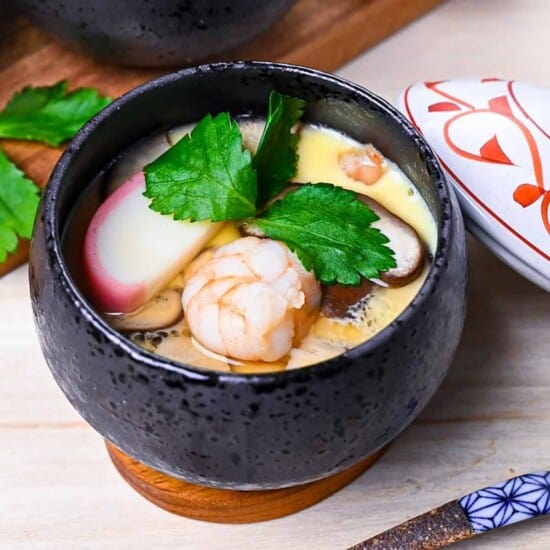


excellent. To reheat, can I steam the cold one?
Hi Edmund,
Thank you for your question!
There are three main ways to reheat chawanmushi: microwave, hot water, or steaming. For the microwave method, cover the chawanmushi with plastic wrap and heat it in 30-second intervals at 600W until it reaches your desired temperature. If using the hot water method, place the container of chawanmushi in a bowl of hot water and let it stand for about 10 minutes. For the steam method, place the chawanmushi in a steamer for about 5 minutes. Whichever method you choose, be careful not to overheat the dish!
Yuto